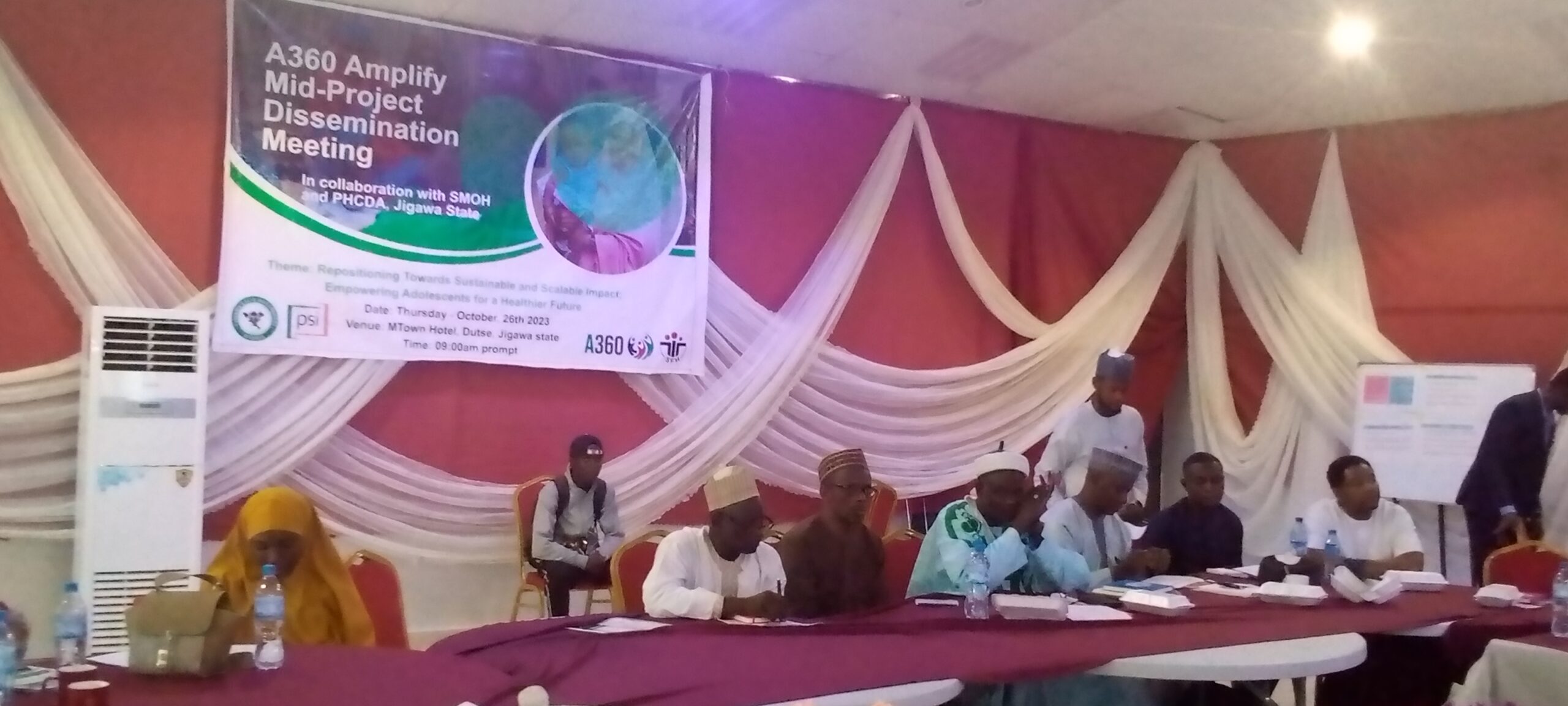Groups task Jigawa govt on emphasising HCD projects for adolescent married girls
Groups task Jigawa govt on emphasising HCD projects for ... Tribune Online


Jigawa State Government Urged to Prioritize Adolescent Married Girls in Human Capital Development Projects

A communique issued after a day-long meeting for the Society for Family Health (SFH) A360 mid-Project destination at Mtown Hotel in Dutse, the state capital, has called upon the Jigawa State government to pay more attention to adolescent married girls in its Human Capital Development (HCD) projects. This is to improve their socio-economic lives and healthcare services.
Efforts in Adolescent Sexual and Reproductive Health
The communique highlighted the significant efforts made by the health sector in the area of Adolescent Sexual and Reproductive Health (ASRH). It mentioned the presence of a good number of youth-friendly service providers, which have contributed to improved adolescent health outcomes.
New Strategy for Pregnant Adolescent Girls
The communique also mentioned a new strategy called the MNCH, which aims to support pregnant adolescent girls. It raised the question of what resources are needed to provide a holistic solution for Adolescent Girls and Young Women in the state.
Appeal for Free Healthcare Services
The communique appealed to the State Ministry of Health for free healthcare services for adolescent students in boarding schools. It highlighted that using the BCHPF, 281 people have already been provided with free healthcare services. It further assured that all boarding school students in Jigawa have access to free healthcare services, and the upcoming TISHUP program will address the needs of tertiary students.
Contraceptive Use and Availability
During the meeting, Dr. Shehu Sambo, the Director of the State Primary Healthcare Development Agency, shared that 30 percent of women of reproductive age in Jigawa are using contraceptives for birth spacing and control. He emphasized that contraceptive commodities and services are available in most public health facilities in the state to ensure easy access for interested women.
However, Dr. Shehu Sambo also noted that there is a shortage of commodities in hospitals due to the increasing demand in both rural and urban areas.
Supporting Women and Adolescent Married Girls
Bethsheba Daure, the State Program Manager, explained that the program aims to support women and adolescent married girls in achieving family health. The meeting was specifically focused on breaking down barriers to voluntary updates on modern contraceptives among girls aged between 15 and 19 in Nigeria. The goal is to improve sexual and reproductive health outcomes for young adolescents and women in Jigawa state.
Increasing Contraceptive Prevalence
The current contraceptive prevalence in Jigawa state is only 4.7%. However, there are hopes to reach 27% by 2024 in order to reduce the fatality rate of women of reproductive age. The high fatality rate of women in Jigawa has significant socio-economic implications for the community.
SDGs, Targets, and Indicators
-
SDG 3: Good Health and Well-being
- Target 3.7: By 2030, ensure universal access to sexual and reproductive healthcare services, including for family planning, information, and education, and the integration of reproductive health into national strategies and programs
- Indicator: Contraceptive prevalence rate
-
SDG 5: Gender Equality
- Target 5.3: Eliminate all harmful practices, such as child, early, and forced marriage and female genital mutilation
- Indicator: Percentage of women aged 20-24 who were married or in a union before age 18
-
SDG 10: Reduced Inequalities
- Target 10.2: By 2030, empower and promote the social, economic, and political inclusion of all, irrespective of age, sex, disability, race, ethnicity, origin, religion, or economic or other status
- Indicator: Percentage of population covered by social protection floors/systems
Table: SDGs, Targets, and Indicators
| SDGs | Targets | Indicators |
|---|---|---|
| SDG 3: Good Health and Well-being | Target 3.7: By 2030, ensure universal access to sexual and reproductive healthcare services, including for family planning, information, and education, and the integration of reproductive health into national strategies and programs | Contraceptive prevalence rate |
| SDG 5: Gender Equality | Target 5.3: Eliminate all harmful practices, such as child, early, and forced marriage and female genital mutilation | Percentage of women aged 20-24 who were married or in a union before age 18 |
| SDG 10: Reduced Inequalities | Target 10.2: By 2030, empower and promote the social, economic, and political inclusion of all, irrespective of age, sex, disability, race, ethnicity, origin, religion, or economic or other status | Percentage of population covered by social protection floors/systems |
Analysis
1. Which SDGs are addressed or connected to the issues highlighted in the article?
The issues highlighted in the article are connected to SDG 3: Good Health and Well-being, SDG 5: Gender Equality, and SDG 10: Reduced Inequalities.
2. What specific targets under those SDGs can be identified based on the article’s content?
Based on the article’s content, the specific targets identified are:
– Target 3.7: By 2030, ensure universal access to sexual and reproductive healthcare services, including for family planning, information, and education, and the integration of reproductive health into national strategies and programs (under SDG 3: Good Health and Well-being)
– Target 5.3: Eliminate all harmful practices, such as child, early, and forced marriage and female genital mutilation (under SDG 5: Gender Equality)
– Target 10.2: By 2030, empower and promote the social, economic, and political inclusion of all, irrespective of age, sex, disability, race, ethnicity, origin, religion, or economic or other status (under SDG 10: Reduced Inequalities)
3. Are there any indicators mentioned or implied in the article that can be used to measure progress towards the identified targets?
Yes, there are indicators mentioned in the article that can be used to measure progress towards the identified targets:
– Contraceptive prevalence rate (indicator for Target 3.7)
– Percentage of women aged 20-24 who were married or in a union before age 18 (indicator for Target 5.3)
– Percentage of population covered by social protection floors/systems (indicator for Target 10.2)
The article mentions the contraceptive prevalence rate as a measure of progress in providing access to reproductive healthcare services. It also highlights the issue of child marriage, which can be measured by the percentage of women aged 20-24 who were married or in a union before age 18. Additionally, the article discusses the need for social protection systems to promote inclusion, indicating the importance of measuring the percentage of population covered by such systems.
Overall, the article provides information relevant to these targets and indicators, highlighting the need for improved healthcare services, elimination of harmful practices, and promotion of inclusivity in Jigawa State.
SDGs, Targets, and Indicators
| SDGs | Targets | Indicators |
|---|---|---|
| SDG 3: Good Health and Well-being | Target 3.7: By 2030, ensure universal access to sexual and reproductive healthcare services, including for family planning, information, and education, and the integration of reproductive health into national strategies and programs | Contraceptive prevalence rate |
| SDG 5: Gender Equality | Target 5.3: Eliminate all harmful practices, such as child, early, and forced marriage and female genital mutilation | Percentage of women aged 20-24 who were married or in a union before age 18 |
| SDG 10: Reduced Inequalities | Target 10.2: By 2030, empower and promote the social, economic, and political inclusion of all, irrespective of age, sex, disability, race, ethnicity, origin, religion, or economic or other status | Percentage of population covered by social protection floors/systems |
Behold! This splendid article springs forth from the wellspring of knowledge, shaped by a wondrous proprietary AI technology that delved into a vast ocean of data, illuminating the path towards the Sustainable Development Goals. Remember that all rights are reserved by SDG Investors LLC, empowering us to champion progress together.
Source: tribuneonlineng.com

Join us, as fellow seekers of change, on a transformative journey at https://sdgtalks.ai/welcome, where you can become a member and actively contribute to shaping a brighter future.







